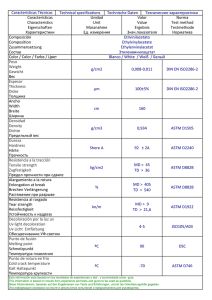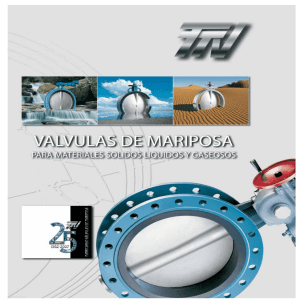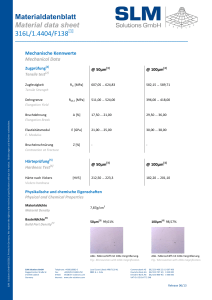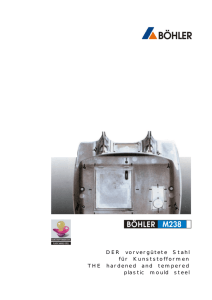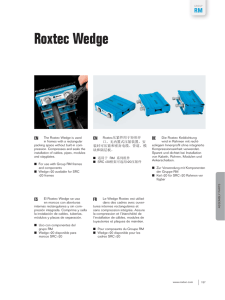austenitic steels
Anuncio
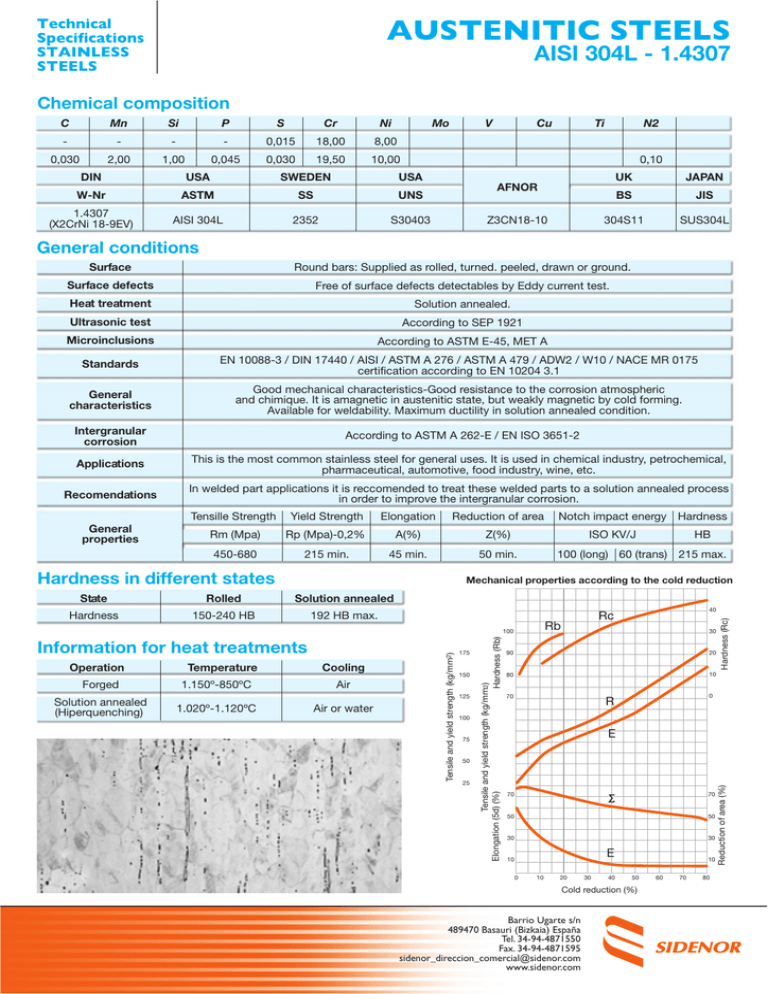
Technical Specifications STAINLESS STEELS AUSTENITIC STEELS AISI 304L - 1.4307 Chemical composition C Mn Si P S Cr Ni - - - - 0,015 18,00 8,00 0,030 2,00 1,00 0,045 0,030 19,50 10,00 DIN USA SWEDEN Mo V Cu Ti N2 0,10 USA W-Nr ASTM SS UNS 1.4307 (X2CrNi 18-9EV) AISI 304L 2352 S30403 UK JAPAN BS JIS 304S11 SUS304L AFNOR Z3CN18-10 General conditions Surface Round bars: Supplied as rolled, turned. peeled, drawn or ground. Surface defects Free of surface defects detectables by Eddy current test. Heat treatment Solution annealed. Ultrasonic test According to SEP 1921 Microinclusions According to ASTM E-45, MET A Standards EN 10088-3 / DIN 17440 / AISI / ASTM A 276 / ASTM A 479 / ADW2 / W10 / NACE MR 0175 certification according to EN 10204 3.1 General characteristics Good mechanical characteristics-Good resistance to the corrosion atmospheric and chimique. It is amagnetic in austenitic state, but weakly magnetic by cold forming. Available for weldability. Maximum ductility in solution annealed condition. Intergranular corrosion According to ASTM A 262-E / EN ISO 3651-2 Applications This is the most common stainless steel for general uses. It is used in chemical industry, petrochemical, pharmaceutical, automotive, food industry, wine, etc. Recomendations In welded part applications it is reccomended to treat these welded parts to a solution annealed process in order to improve the intergranular corrosion. Tensille Strength Yield Strength Elongation Reduction of area Rm (Mpa) Rp (Mpa)-0,2% A(%) Z(%) 450-680 215 min. 45 min. 50 min. Hardness in different states ISO KV/J 100 (long) 60 (trans) 215 max. Solution annealed Hardness 150-240 HB 192 HB max. Rb 1.150º-850ºC Air Solution annealed (Hiperquenching) 1.020º-1.120ºC Air or water 175 150 125 100 75 50 25 Tensile and yield strength (kg/mm2) Elongation (5d) (%) Hardness (Rb) Cooling Forged Tensile and yield strength (kg/mm2) 100 Information for heat treatments 40 Rc 30 90 20 80 10 70 Hardness (Rc) Rolled Temperature HB Mechanical properties according to the cold reduction State Operation Notch impact energy Hardness 0 R E 70 70 50 50 30 30 E 10 0 10 20 30 40 10 50 Cold reduction (%) Barrio Ugarte s/n 489470 Basauri (Bizkaia) España Tel. 34-94-4871550 Fax. 34-94-4871595 [email protected] www.sidenor.com 60 70 80 Reduction of area (%) General properties Technische Spezifikationen NICHTROSTENDE STÄHLE AUSTENITISCHE STÄHLE AISI 304L - 1.4307 Chemische Zusammensetzung C Mn Si P S Cr Ni - - - - 0,015 18,00 8,00 0,030 2,00 1,00 0,045 0,030 19,50 10,00 DIN USA SCHWEDEN Mo V Cu Ti N2 0,10 USA W-Nr ASTM SS UNS 1.4307 (X2CrNi 18-9EV) AISI 304L 2352 S30403 UK JAPAN BS JIS 304S11 SUS304L AFNOR Z3CN18-10 Allgemeine Bedingungen Oberfläche Rundstahl:gewalzt,geschält,überdreht,gezogen oder geschliffen und Knüppel. Oberlfächenfehler Frei von Oberflächenfehlern nachweisbar durch Wirbelstromprüfung. Wärmebehandlung Lösungsgeglüht. US-prüfung Gemäss SEP 1921 Mikroeinschlüsse Gemäss ASTM E-45, Met. A Standardnormen EN 10088-3 / DIN 17440 / AISI / ASTM A 276 / ASTM A 479 / ADW2 / W10 / NACE MR 0175 Werkszeugnis nach EN 10204 3.1 Allgemeine Merkmale Gute mechanische Eigenschaften, hohe Korrosionsbeständigkeit bei atmosphärischen und chemischen Einflüssen. Die magnetischen Eigenschaften werden durch Kaltumformung geringer, amagnetisch in austenitischem Zustand. Gut schweissbar, maximale Formbarkeit in lösungsgelühtem, abgeschreckten Zustand. Interkristalline Korrosion Gemäss ASTM A 262-E / EN ISO 3651-2 Anwendungen Diese Güte kommt in zahlreichen Gebieten zur Anwendung, z.B. in der Chemieindustrie, Erdölindustrie, Pharmaindustrie, Automobilindustrie, Lebensmittel-/Weinindustrie. Empfehlungen Um interkristalline Korrosion zu vermeiden, sollten geschweisste Teile einer Wärmebehandlung (lösungsgeglüht) unterzogen werden. Zugfestigkeit Dehngrenze Bruchdehnung Flächenreduzierung Rm (Mpa) Rp (Mpa)-0,2% A(%) Z(%) 450-680 215 min. 45 min. 50 min. Härte und Festigkeit in verschiedenen Ausführungen Härte 150-240 HB 192 HB max. Information über Wärmebehandlung Verfahren Temperatur Abkühlung Schmieden 1.150º-850ºC Luft Lösungsgeglüht 1.020º-1.120ºC Luft oder wasser ISO KV/J HB 100 (länge) 60 (quer) 215 max. 40 Rc Rb 100 175 150 125 100 75 50 25 30 90 20 80 10 70 Härte (Rc) Lösungsgeglüht Härte 0 R E 70 70 50 50 30 30 E 10 0 10 20 30 40 10 50 Kaltumformung (%) Barrio Ugarte s/n 489470 Basauri (Bizkaia) España Tel. 34-94-4871550 Fax. 34-94-4871595 [email protected] www.sidenor.com 60 70 80 Einschnürung (%) Gewalzt Zugfestigkeit und Streckgrenze (N/mm2) Ausführung Kerbschlagarbeit Mechanische Eigenschaften gemäss Kaltumformung Zugfestigkeit und Streckgrenze (N/mm2) Härte (Rb) Bruchdehnung (5d) (%) Allgemeine Eigenschaften
